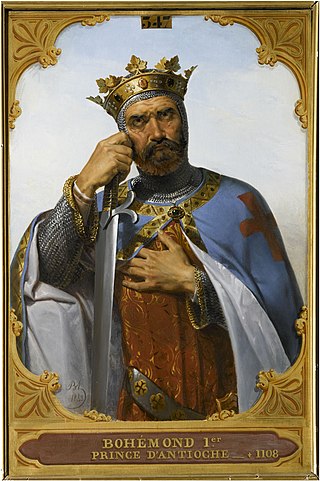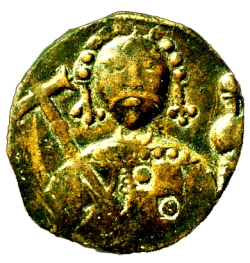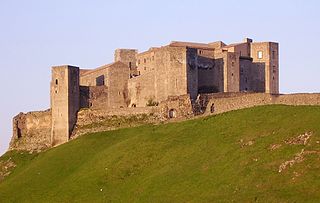
Bohemond I of Antioch, also known as Bohemond of Taranto or Bohemond of Hauteville, was the prince of Taranto from 1089 to 1111 and the prince of Antioch from 1098 to 1111. He was a leader of the First Crusade, leading a contingent of Normans on the quest eastward. Knowledgeable about the Byzantine Empire through earlier campaigns with his father, he was the most experienced military leader of the crusade.

Robert "Guiscard" de Hauteville, sometimes Robert "the Guiscard", was a Norman adventurer remembered for his conquest of southern Italy and Sicily in the 11th century.

Roger I, nicknamed “Roger Bosso” and “Grand Count Roger”, was a Norman nobleman who became the first Grand Count of Sicily from 1071 to 1101.

The Battle of Civitate was fought on 18 June 1053 in southern Italy, between the Normans, led by the Count of Apulia Humphrey of Hauteville, and a Swabian-Italian-Lombard army, organised by Pope Leo IX and led on the battlefield by Gerard, Duke of Lorraine, and Rudolf, Prince of Benevento. The Norman victory over the allied papal army marked the climax of a conflict between the Norman mercenaries who came to southern Italy in the eleventh century, the de Hauteville family, and the local Lombard princes. By 1059 the Normans would create an alliance with the papacy, which included a formal recognition by Pope Nicholas II of the Norman conquest in south Italy, investing Robert Guiscard as Duke of Apulia and Calabria, and Count of Sicily.

The Battle of Dyrrhachium took place on October 18, 1081 between the Byzantine Empire, led by the Emperor Alexios I Komnenos, and the Normans of southern Italy under Robert Guiscard, Duke of Apulia and Calabria. The battle was fought outside the city of Dyrrhachium, the major Byzantine stronghold in the western Balkans, and ended in a Norman victory.
Sikelgaita was a Lombard princess, the daughter of Prince Guaimar IV of Salerno and second wife of Duke Robert Guiscard of Apulia. Her heritage made her a vital asset to Robert's governance in Southern Italy, legitimizing his reign and that of his successors. Sikelgaita frequently accompanied Robert on campaigns and is noted for leading troops in battle. She continued to be a significant source of support for her primary heir, Roger Borsa, and remained actively involved in politics until her death.

Humphrey of Hauteville, surnamed Abagelard, was the count of Apulia and Calabria from 1051 to his death.
GaufredoMalaterra was an eleventh-century Benedictine monk and historian, possibly of Norman origin. He travelled to the southern Italian peninsula, passing some time in Apulia before entering the monastery of Sant'Agata at Catania, on the isle of Sicily. Malaterra indicates that, prior to his arrival in Catania, he had spent an undefined period away from monastic life, in the worldly service of "Martha".
William of Apulia was a poet and chronicler of the Normans, writing in the 1090s. His Latin epic, Gesta Roberti Wiscardi, written in hexameters, is one of the principal contemporary sources for the Norman conquest of southern Italy, especially the career of Robert Guiscard, Duke of Apulia (1059–1085).

Amatus of Montecassino, was a Benedictine monk of the Abbey of Montecassino who is best known for his historical chronicles of his era. His History of the Normans, is one of three principle primary sources for the Norman Conquest of southern Italy--the other two being the histories of William of Apulia and Geoffrey Malaterra. Amatus describes the Normans from the perspective of his abbey, one of the most important religious and cultural centers in Italy at the time. His history is the earliest extant account of the Norman sieges of Bari and Salerno, their conquest of Sicily, and the careers of both Robert Guiscard and Richard Drengot, as well as the Gregorian Reforms seen from the papal point of view.
Richard Drengot was the count of Aversa (1049–1078), prince of Capua and duke of Gaeta (1064–1078).

Alberada of Buonalbergo, was a duchess of Apulia as the first wife of Robert Guiscard, duke of Apulia (1059–1085).

The Norman conquest of southern Italy lasted from 999 to 1194, involving many battles and independent conquerors.

Byzantine–Norman wars were a series of military conflicts between the Normans and the Byzantine Empire fought from c. 1040 to 1186 involving the Norman-led Kingdom of Sicily in the west, and the Principality of Antioch in the Levant. The last of the Norman invasions, though having incurred disaster upon the Romans by sacking Thessalonica in 1185, was eventually driven out and vanquished by 1186.

The Castle of Melfi in Basilicata is a monument owned by the Italian State and one of the most important medieval castles in Southern Italy. Its construction, at least the components still visible, dates back to the Norman conquest and has undergone significant changes over time, especially under the House of Anjou and the Crown of Aragon.

The Abbey of Santissima Trinità or Abbey of the Most Holy Trinity, Italian: Abbazia della Santissima Trinità, is a Roman Catholic abbey complex at Venosa, in the Vulture area of the province of Potenza, in the southern Italian region of Basilicata. The architecture of the abbey shows Roman, Lombard, and Norman influences. The complex lies within the Parco Archeologico of Venosa, approximately 1.5 km north-east of the town; it falls under the Roman Catholic Diocese of Melfi-Rapolla-Venosa. It consists of the old church, of uncertain date; the monastery buildings; and the Incompiuta, the unfinished or new church, begun in the last quarter of the eleventh century and never completed. The complex was declared a National Monument by Royal Decree on 20 November 1897. It is no longer a monastery, but is used by the Trinitarian Order.

The Battle of Cerami was fought in June 1063 and was one of the most significant battles in the Norman conquest of Sicily, 1060–1091. The battle was fought between a Norman expeditionary force and a Muslim alliance of Sicilian and Zirid troops. The Normans fought under the command of Roger de Hauteville, the youngest son of Tancred of Hauteville and brother of Robert Guiscard. The Muslim alliance consisted of the native Sicilian Muslims under the Kalbid ruling class of Palermo, led by Ibn al-Hawas, and Zirid reinforcements from North Africa led by the two princes, Ayyub and 'Ali. The battle was a resounding Norman victory that utterly routed the opposing force, causing divisions amongst the Muslim aristocracy which ultimately paved the way for the eventual capture of the Sicilian capital, Palermo, by the Normans and subsequently the rest of the island.
Robert of Bounalbergo, son of Gerard (Girard) of Buanalbergo and his wife whose name is unknown. Girard was the nephew of Alberada of Buonalbergo, who married Robert Guiscard and was mother to Bohemond I of Antioch.
The Battle of Larissa was a military engagement between the armies of the Byzantine Empire and the Italo-Norman County of Apulia and Calabria. On 3 November 1082, the Normans besieged the city of Larissa. In July of the following year, Byzantine reinforcements attacked the blockading force, harassing it with mounted archers and spreading discord among its ranks through diplomatic techniques. The demoralized Normans were forced to break off the siege.
Fressenda was an 11th-century Norman noblewoman and the wife of Tancred of Hauteville. She is known as the mother of Robert Guiscard and Roger I of Sicily.











